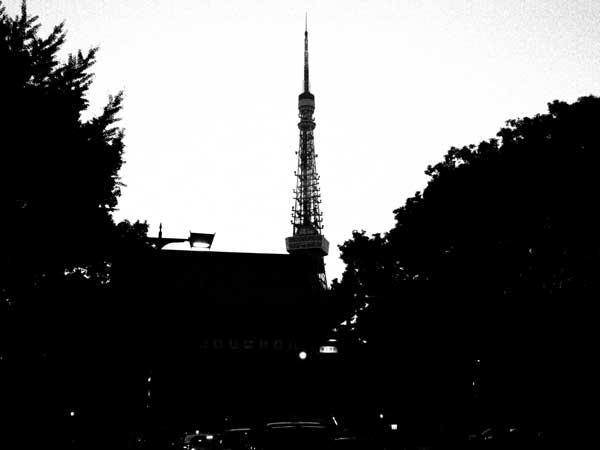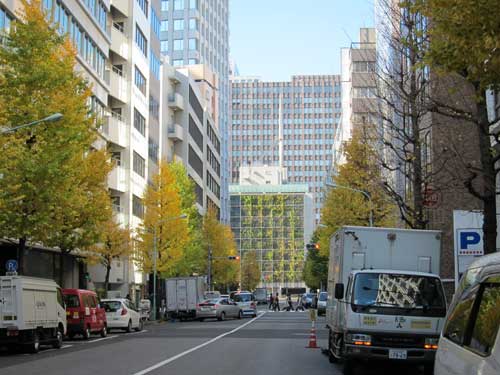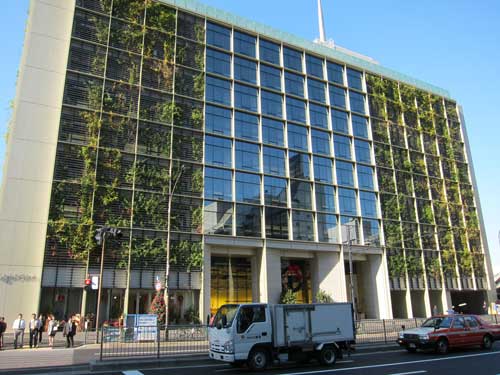
ゴールデンゲート橋の下に、ゲイ浜があります。

最近、クスノキという巨大な木について知りました。中伊豆で見たものは、幹に苔がいっぱい生えていました。東京のオフィス・タワーの前にも、もっと乾燥したクスノキを見つけました。とても素敵だと思います。
I recently noticed this giant evergreen tree called camphor (or kusunoki in Japanese). A single, well cared for tree can easily become a local landmark. The above tree is in a mountaineous area of Izu. Below in front of a glass and metal tower in Shiba, across from Tokyo Tower.


芝のアウトドアのプールが閉まる前に、晩夏の東京タワーの写真をたくさんとりました。東京タワーは東京の数少ないランドマークですね。「ランドマーク」とは、自分の居場所がわかるような目立つ建物のことです。
Before the Shiba outdoor pool closed in mid-September, I spent more time admiring Tokyo Tower, both from the pool itself and from park surrounding it. I’ll post a few photos of this rare Tokyo landmark in the next week.

最近買ったCanon G1Xというデジタルカメラの使い方をまだ勉強しているが、よく間違います。HDRという設定を使って、動いている車が反復して映ります。芝公園の増上寺で。
I am still getting used to my new (used) Canon G1X digital camera. I mistakenly used the HDR (high dynamic range) setting, and it created this ghost like effect of the car traffic passing the crosswalk. I like the contrast between the dynamic street and the stately landmarks.

東京タワーは東京の数少ないランドマークの一つです。ニューヨークやパリと全然違います。東京には終わりもなければ、中心もありません。川からの有名な景色もなくて、他の都市にあるように超高層ビルが並ぶ景色もありません。東京タワーは昭和のレトロモダンです。
Few buildings in Tokyo are as iconic as Tokyo Tower. In a mega-city that sprawls as far as Japan’s second largest city, Yokohama, Tokyo lacks a single center, a recognizable river, or a conventional view of its skyscrapers, unlike NYC’s Hudson River or Central Park views.
I like how the top photo’s framing of Tokyo Tower mixes auto traffic with mature trees and a shrine entrance gate in a nostalgic ode to the 1950s. The lower photo shows its reflection at night in an office mid-rise.


スカイツリーはほとんど出来上がりました。英語をしゃべる人にこの片仮名の名前はちょっと変です。錦糸町駅で写真をとりました。
Sky Tree, Tokyo’s tallest landmark, will be finished at the end of this year, and opening next spring. In Japanese it’s pronounced Sukai Tsurii. This is the view from Kinshichou station just south of the tower.

最近、古いケヤキを支える木造の補助 ができました。下を歩くと、近所の方も、この補助と木を見ているのに気がつきました。2つの役割 があります。木を守るだけでなく、近所の方がこの木は特別だと気がつきます。多分、この木はこの近所で一番古い木です。木造の補助は神社の鳥居みたいです。
Recently, I’ve noticed this enormous new wood support for the giant zelkova tree in front of my local elementary school. I’ve noticed other neighbors stopping to admire the giant support and the tree.
I like how the elegant support structure protects the tree and also draws attention to its significance. This traditional style Japanese garden technique also evokes the gates outside Shinto shrines.
I’ve blogged about this landmark tree before in April and also last year. One sign says that it’s 1,000 years old. While I doubt that, it’s still a remarkable tree, and probably the oldest living being in the neighborhood.

高層オフィスビルの垂直な庭はオフィス街を活気のある場所にする。
One office tower’s vertical garden brings new life to Tokyo’s business district.
Pasona’s headquarter’s vertical garden is filling out and bringing new life to the crowded office streetscape between Nishonbashi and Tokyo Station. The lushly planted wall includes many traditional Japanese garden plants and imports such as blueberry bushes. I like how it contrasts with the surrounding office towers, from the 1980s to recent years, and demonstrates that the potential for office wall gardens to benefit everyone inside and outside the building.

It’s amazing how much the garden has grown since I last visited Pasona in May. I am very excited to see this corporate garden become a landmark in the Yaesu district. It would be great for Mori or Mitsubishi to follow this example and experiment with vertical gardens and wildlife habitats on much taller Tokyo buildings. I also hope that Pasona continues to innovate with its urban landscape. Sidewalk gardens? More fruit trees? Butterfly hatcheries? Honeybees? Falcon’s nests?
Below are some details photos, including leaves that have turned red this fall, and some late-in-the-year pink roses.



The fall sky is incredibly clear, and we often see Mount Fuji from our balcony at sunrise and sunset in these months. Still there are times I go out into our narrow high-rise garden, look out, and feel startled and humbled by the overwhelming beauty of this celebrated natural and spiritual landmark.
The world’s most famous natural landmarks are in some ways like our global cities’the most famous built landmarks. Mount Fuji, like the Eiffel Tower, has a form and mythology that all of us know before setting eyes on it.
Mount Fuji has been represented over many centuries and in many forms, from fine art, most notably Hokusai’s 36 Views of Mount Fuji, to countless sento mosaics. Until the Meiji era, women were prohibited from its summit. Yet despite our investing so many cultural meanings on this mountain, its presence exceeds human memory and most likely our specie’s future.
Mount Fuji’s sublime appearance on the horizon lifts our vision from a prosaic cityscape, packed with non-descript, high-rise and low-rise residences, television, cellphone and lightening antennas, giant power lines, and a garbage incinerator. As a dormant volcano it, too, has a temporal form, yet its scale and longevity makes our human presence feel very transitory.

Approaching by foot or by car, you would not know that up ahead is one of Tokyo’s most famous historic landmarks, Nihonbashi (日本橋, or literally Japan Bridge). During Edo, it was an important wooden bridge in the center of the capital. Today, Japan’s highway network uses the bridge as the zero mile marker.

Despite its landmark status, the 1911 stone bridge is obscured by the elevated freeway. When I visited, I saw a pair of elderly Japanese tourists taking photos of themselves with the bridge. The many pedestrians and the speeding cars on street and freeway level showed no signs of recognition that this space was special.

Like many of Tokyo’s rivers, what could be natural habitat and urban attraction has become dead space. Apart from one outdoor hotel cafe, the neighboring buildings face away from the river, freeway, pillars, and exhaust.
